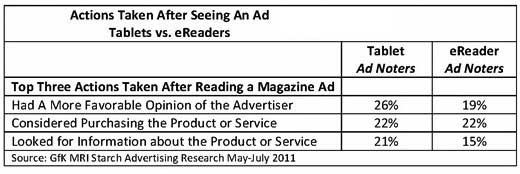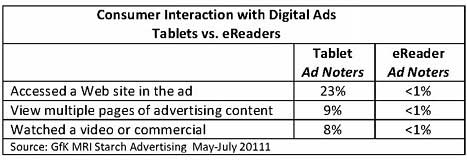Ads viewed on tablet devices are more likely than ads on e-readers to attract the attention of consumers and engage them in key buying-related activities, according to a new study by GfK MRI Starch Advertising Research, which explores how digital magazine readers respond to ads on the two platforms.
On average, 55% of surveyed consumers who read magazines on tablets "noted" (saw or read) a magazine ad on their device, compared with 41% of those using e-readers.

Tablet ads are even more successful than print ads: Among hard copy ads measured by Starch Research in 2010, the average noting score was 53%.
Below, additional findings from a survey of roughly 7,000 users of magazine apps on tablets and e-readers, by Starch Advertising Research, a unit of GfK MRI.
Tablets Drive Stronger Engagement
Among consumers who noted an ad, tablet users were more likely than e-reader users to have a more favorable opinion of the ad (26% vs. 19%) and search for information about the product or service after viewing the ad (21% vs. 15%).

An equal proportion (22%) of ad noters on both tablets and e-readers said magazine ads drove them to consider purchasing the product/service. (However, the number of consumers who noted ads on a tablet was greater in the first place.)
Looking for great digital marketing data? MarketingProfs reviewed hundreds of research sources to create our most recent Digital Marketing Factbook (May 2010), a 296-page compilation of data and 254 charts, covering email marketing, social media, search engine marketing, e-commerce, and mobile marketing. Also check out The State of Social Media Marketing, a 240-page original research report from MarketingProfs.
Tablets Encourage More Interaction With Ads
Among digital magazine readers who noted an ad, 23% of tablet users accessed a website via the ad, 9% viewed multiple pages of ad content, and 8% watched a video or commercial embedded in the ad.

By contrast, less than 1% of those who viewed a magazine ad on an e-reader took any of those actions, likely because ads on e-readers typically have fewer interactive bells and whistles, according to the study.
About the study: Starch Advertising Research, a unit of GfK MRI, surveyed approximately 7,000 users of magazine apps on tablets and e-readers, from May to July, 2011.



